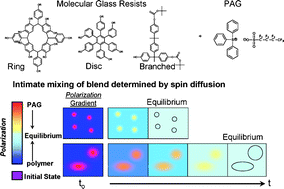Solid state NMR investigation of photoresist molecular glasses including blend behavior with a photoacid generator†
Abstract
We have examined four molecular glass (MG) materials that show promise as photoresists for extreme-ultraviolet (EUV)

* Corresponding authors
a
Polymers Division, National Institute of Standards and Technology, Gaithersburg, MD, USA
E-mail:
vprabhu@nist.gov
b Department of Chemistry and Chemical Biology, Cornell University, Ithaca, NY, USA
c Department of Chemical and Biomolecular Engineering, Cornell University, Ithaca, NY, USA
d
Department of Materials Science and Engineering, Cornell University, Ithaca, NY, USA
E-mail:
cober@ccmr.cornell.edu
We have examined four molecular glass (MG) materials that show promise as photoresists for extreme-ultraviolet (EUV)

 Please wait while we load your content...
Something went wrong. Try again?
Please wait while we load your content...
Something went wrong. Try again?
D. L. VanderHart, V. M. Prabhu, A. De Silva, N. M. Felix and C. K. Ober, J. Mater. Chem., 2009, 19, 2683 DOI: 10.1039/B816290E
To request permission to reproduce material from this article, please go to the Copyright Clearance Center request page.
If you are an author contributing to an RSC publication, you do not need to request permission provided correct acknowledgement is given.
If you are the author of this article, you do not need to request permission to reproduce figures and diagrams provided correct acknowledgement is given. If you want to reproduce the whole article in a third-party publication (excluding your thesis/dissertation for which permission is not required) please go to the Copyright Clearance Center request page.
Read more about how to correctly acknowledge RSC content.
 Fetching data from CrossRef.
Fetching data from CrossRef.
This may take some time to load.
Loading related content
